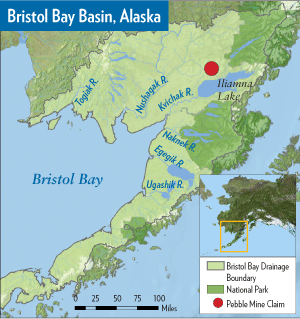January 21, 2014
By Becky Bohrer
ASSOCIATED PRESS
JUNEAU — U.S. Sen. Mark Begich has come out against the proposed Pebble Mine, calling the massive gold-and-copper project “the wrong mine in the wrong place for Alaska.”
In a statement released by his office Monday, Begich said he has long supported Alaska’s mining industry and believes continued efforts must be made to support resource-development industries that help keep Alaska’s economy strong. But he said “years of scientific study (have) proven the proposed Pebble Mine cannot be developed safely in the Bristol Bay watershed.”
“Thousands of Alaskans have weighed in on this issue, and I have listened to their concerns,” he said. “Pebble is not worth the risk.”
In 2011, the U.S. Environmental Protection Agency initiated a review of large-scale mining in the Bristol Bay region in response to concerns about the impact of the proposed Pebble Mine on fisheries. The agency released its final report last week, concluding that large-scale mining in the Bristol Bay watershed posed significant risks to salmon and Alaska Native cultures that rely on it. The region is home to a world-premier sockeye salmon fishery.

Image source: Wild Salmon Center.org
The report did not recommend any policy or regulatory decisions. But EPA regional administrator Dennis McLerran said it would serve as the scientific foundation for the agency’s response to the tribes and others who petitioned EPA to use its authority under the Clean Water Act to protect Bristol Bay. Mine opponents have been pressing the agency to take steps to block or limit the project.
Begich, a Democrat, is the only member of the state’s congressional delegation to outright oppose the project, and his position, first reported by the Anchorage Daily News, won praise from Pebble critics on Monday.
Sen. Lisa Murkowski and Rep. Don Young, both Republicans, last week expressed concerns that the EPA report could be used to pre-emptively veto the project, saying that would set a bad precedent.
“If the EPA has concerns about the impact of a project there is an appropriate time to raise them – after a permit application has been made, not before,” Murkowski said in a release.
Under section 404c of the Clean Water Act, the EPA has the authority to restrict, prohibit, deny or withdraw use of an area as a disposal site for dredged or fill material if the discharge would have “unacceptable adverse” effects on things like municipal water supplies or fisheries, according to an EPA fact sheet. The agency says it has issued just over a dozen final veto actions since 1972.
Mike Heatwole, a spokesman for the Pebble Limited Partnership, the group behind the project, said Pebble is disappointed that Begich had “come out against thousands of new jobs, hundreds of millions in state revenue, and potentially billions in economic activity for Alaska.”
Heatwole said in a statement that it is “no secret that there is a substantial difference of opinion regarding the science of EPA’s recent Bristol Bay Assessment. Not many Alaskans think EPA is impartial.”
He said there is a process that exists for evaluating a project, and there is no environmental harm in allowing Pebble to follow that permitting process.
Begich told The Associated Press that one of the complaints he hears from the mining industry is that it needs to know what federal agencies want before getting too far along in the permitting process. He said if Pebble intends to apply for a permit, the watershed assessment provides a framework for what to respond to before the permit process starts.
